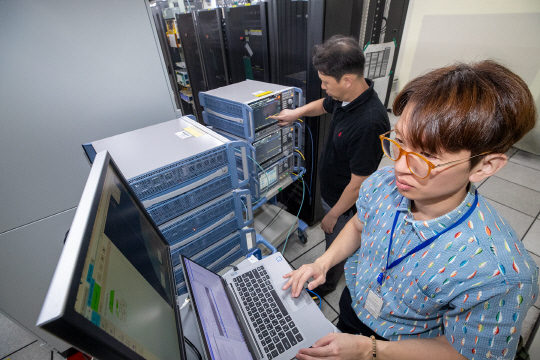
A KT researcher is verifying the connection between the Mugunghwa satellite and 5G network at the KT Research and Development Center. Provided by KT, ‘KT and KT SAT announced on the 30th that they have successfully secured technology to integrate the Mugunghwa-6 satellite located at an orbit altitude of 35,800 kilometers with 5G NTN (Non-Terrestrial Network) standards, connecting terrestrial 5G networks with the satellite communication partner. This is the world’s first application of the 5G NTN standard to a Geostationary Orbit (GEO) satellite.’,
,
, ‘The test was conducted at the KT SAT Geumsan Satellite Center through collaboration with KT, KT SAT, Roedeshwartz Korea, and Viavi Solutions Korea.’,
,
, ‘5G NTN is a standard technology that significantly expands the range of 5G services by utilizing satellites instead of ground-based base stations. This technology was defined in 3GPP Release 17 and completed in 2022.’,
,
, ‘With 5G NTN, services can be provided even in coverage gaps such as maritime, aviation, and mountainous areas where data transmission speeds on terrestrial 5G networks are slower. By leveraging the seamless transition between existing 5G networks and 5G NTN coverage, uninterrupted services can be provided.’,
,
, ‘The core technology of satellite communication is accurately handling the long delays caused by long distances and frequency changes due to satellite movement. In this test process, KT implemented technology to correct long delays of approximately 35,800 kilometers using 5G NTN technology.’,
,
, ‘Standard work for technology that partially replaces ground-based 5G networks using 5G NTN is in progress in 3GPP Release 19. KT plans to conduct technical verification tests immediately upon completion of the standard.’,
,
, ‘In addition, KT plans to secure NTN technology that integrates with various aerospace communication platforms supported by 3GPP 5G NTN standards, such as geostationary satellites, medium Earth orbit satellites, low Earth orbit satellites, and stratospheric communication platforms, in addition to the geostationary satellites used in the technology acquisition process.’,
,
, ‘Jong-Sik Lee, KT Network Research Institute Director (Executive Vice President) stated, “The NTN technology that is beginning to be defined in the 5G Advanced standard will be a core technology for the future 6G,” adding, “In the 6G era, communication coverage will expand to the three-dimensional aerospace area beyond ground limitations, ushering in a truly ubiquitous communication era.” \n’]

